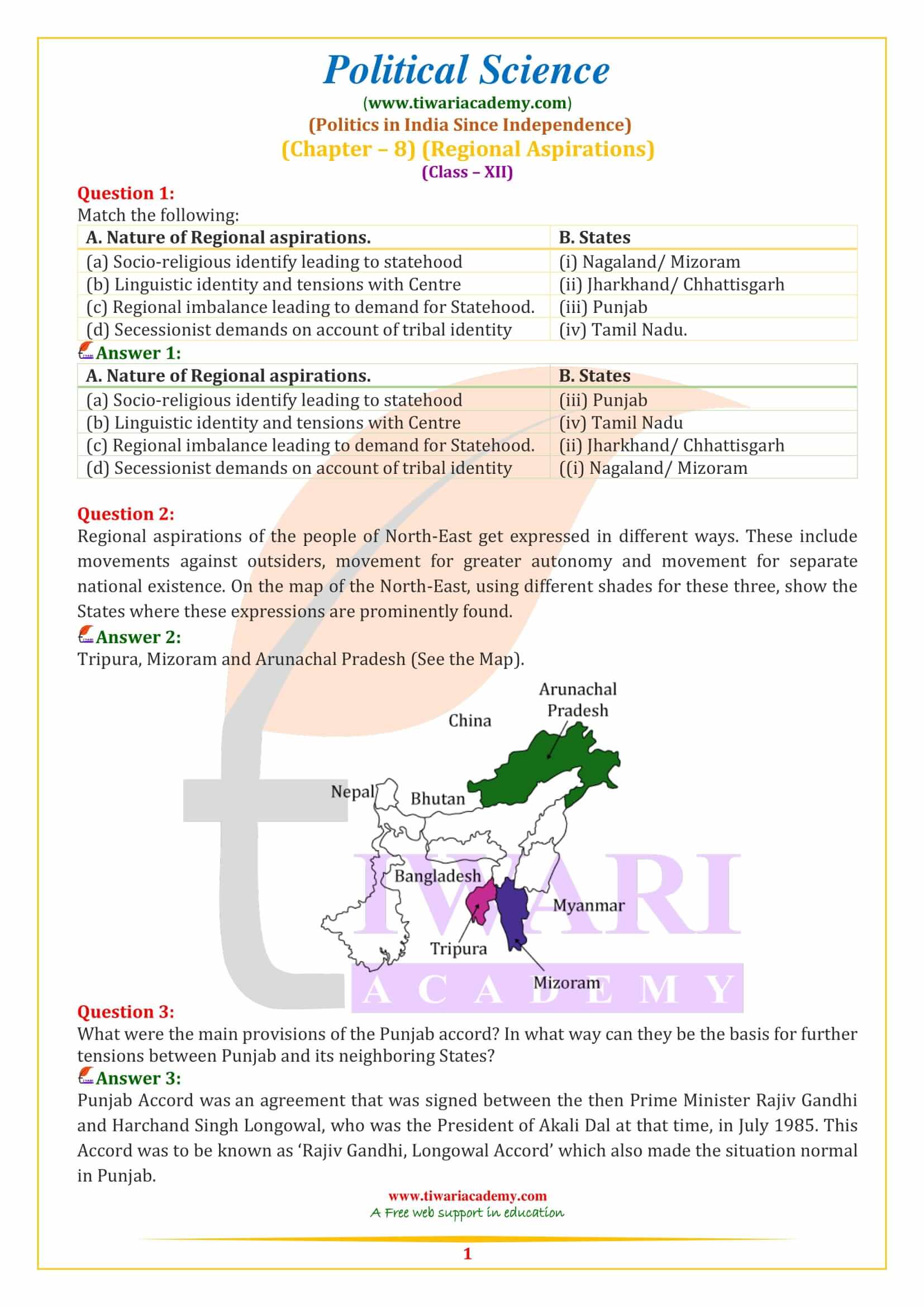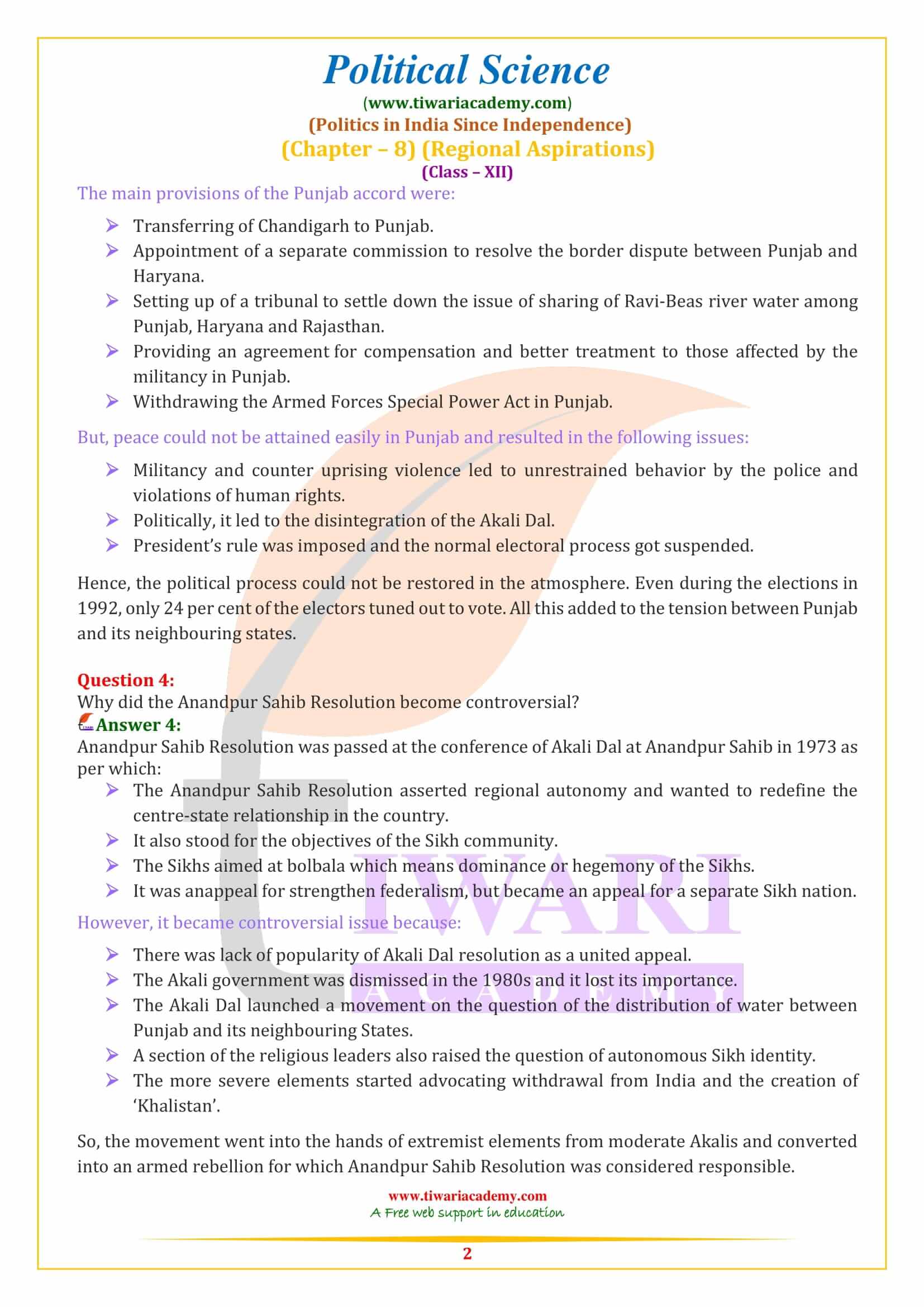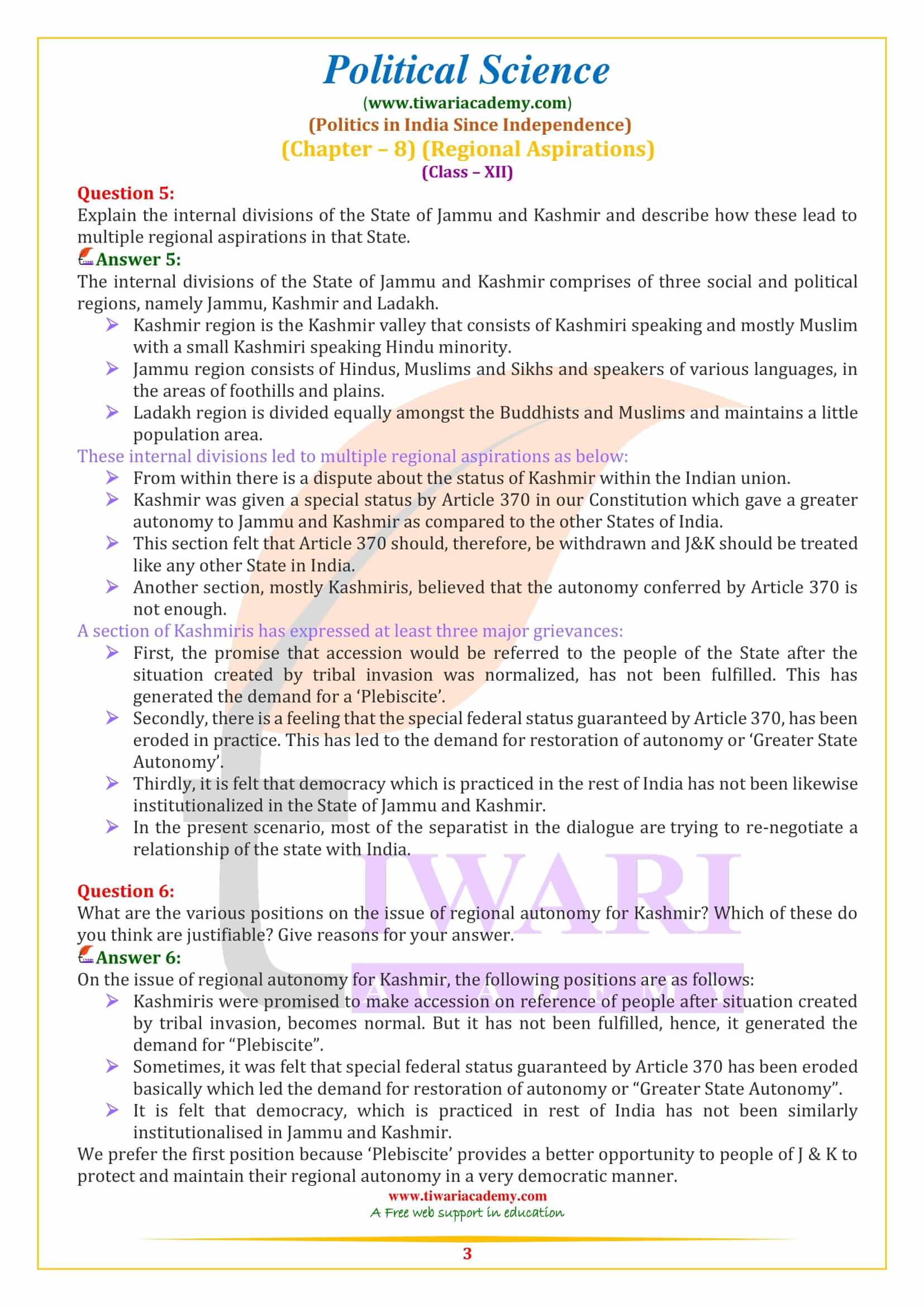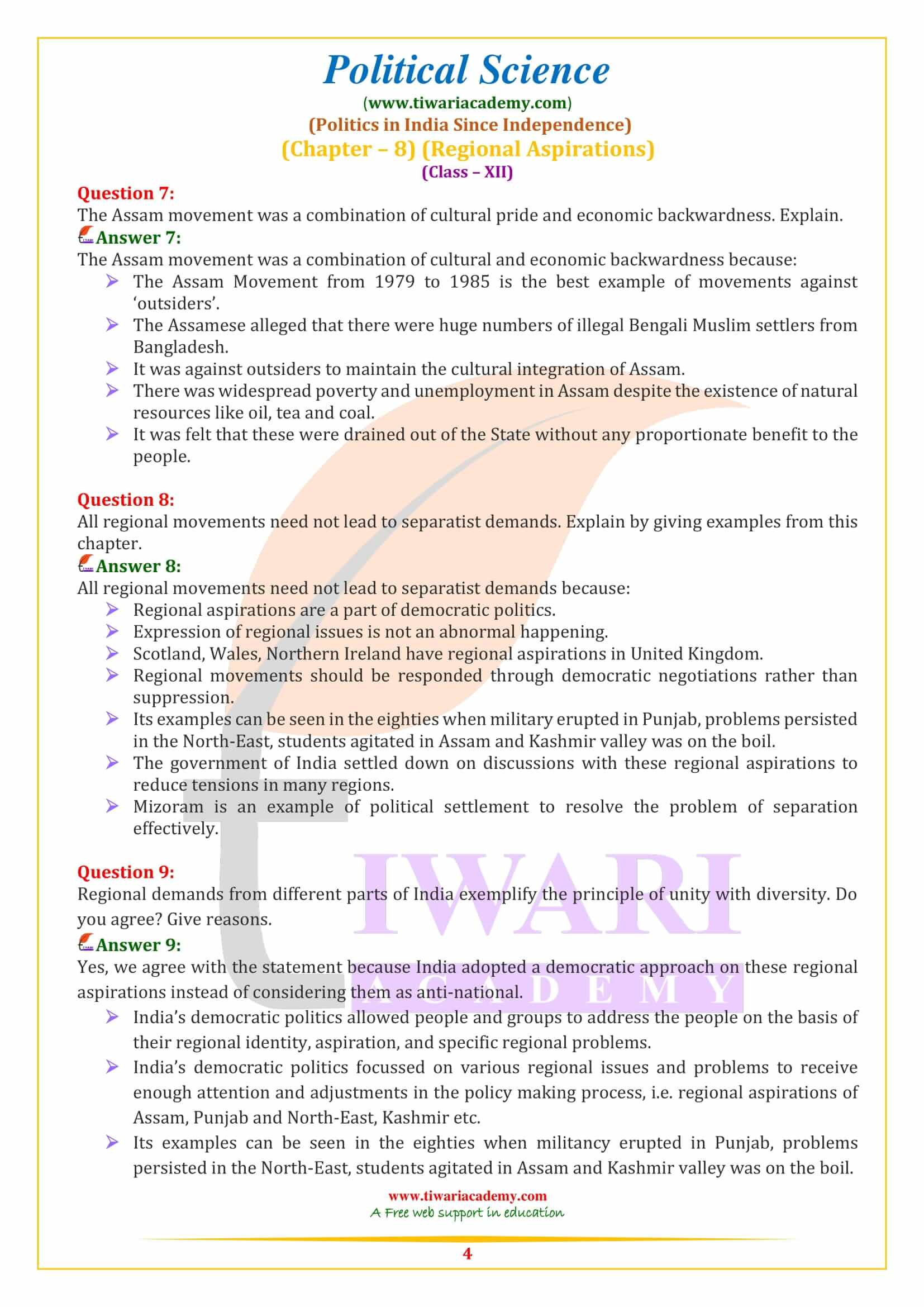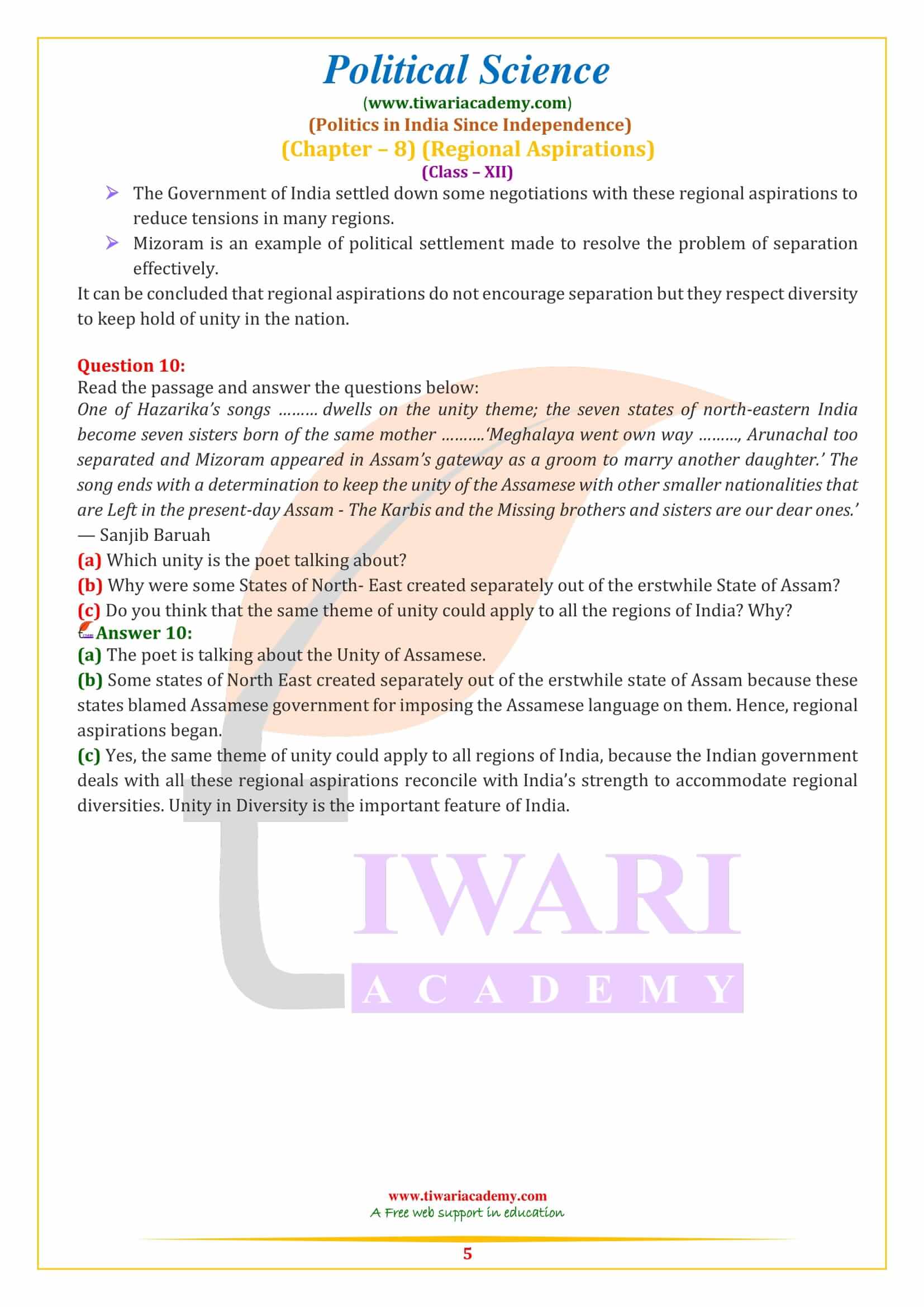NCERT Solutions for Class 12 Political Science Part 2 Chapter 8 Regional Aspirations updated for new academic session 2025-26. The solutions of Class 12 Political Science Part 2 Politics in India since Independence chapter 8 are in Hindi and English Medium following the new NCERT textbooks.
NCERT Solutions for Class 12 Political Science Chapter 8
Class 12 Political Science Chapter 8 Regional Aspirations
What were the main provisions of the Punjab accord? In what way can they be the basis for further tensions between Punjab and its neighboring States?
Punjab Accord was an agreement that was signed between the then Prime Minister Rajiv Gandhi and Harchand Singh Longowal, who was the President of Akali Dal at that time, in July 1985. This Accord was to be known as ‘Rajiv Gandhi, Longowal Accord’ which also made the situation normal in Punjab.
The main provisions of the Punjab accord were:
- Transferring of Chandigarh to Punjab.
- Appointment of a separate commission to resolve the border dispute between Punjab and Haryana.
- Setting up of a tribunal to settle down the issue of sharing of Ravi-Beas river water among Punjab, Haryana and Rajasthan.
- Providing an agreement for compensation and better treatment to those affected by the militancy in Punjab.
- Withdrawing the Armed Forces Special Power Act in Punjab.
But, peace could not be attained easily in Punjab and resulted in the following issues:
- Militancy and counter uprising violence led to unrestrained behavior by the police and violations of human rights.
- Politically, it led to the disintegration of the Akali Dal.
- President’s rule was imposed and the normal electoral process got suspended.
Hence, the political process could not be restored in the atmosphere. Even during the elections in 1992, only 24 per cent of the electors tuned out to vote. All this added to the tension between Punjab and its neighbouring states.
Why did the Anandpur Sahib Resolution become controversial?
Anandpur Sahib Resolution was passed at the conference of Akali Dal at Anandpur Sahib in 1973 as per which:
- The Anandpur Sahib Resolution asserted regional autonomy and wanted to redefine the centre-state relationship in the country.
- It also stood for the objectives of the Sikh community.
- The Sikhs aimed at bolbala which means dominance or hegemony of the Sikhs.
- It was anappeal for strengthen federalism, but became an appeal for a separate Sikh nation.
However, it became controversial issue because:
- There was lack of popularity of Akali Dal resolution as a united appeal.
- The Akali government was dismissed in the 1980s and it lost its importance.
- The Akali Dal launched a movement on the question of the distribution of water between Punjab and its neighbouring States.
- A section of the religious leaders also raised the question of autonomous Sikh identity.
- The more severe elements started advocating withdrawal from India and the creation of ‘Khalistan’.
So, the movement went into the hands of extremist elements from moderate Akalis and converted into an armed rebellion for which Anandpur Sahib Resolution was considered responsible.
Explain the internal divisions of the State of Jammu and Kashmir and describe how these lead to multiple regional aspirations in that State.
The internal divisions of the State of Jammu and Kashmir comprises of three social and political regions, namely Jammu, Kashmir and Ladakh.
- Kashmir region is the Kashmir valley that consists of Kashmiri speaking and mostly Muslim with a small Kashmiri speaking Hindu minority.
- Jammu region consists of Hindus, Muslims and Sikhs and speakers of various languages, in the areas of foothills and plains.
- Ladakh region is divided equally amongst the Buddhists and Muslims and maintains a little population area.
These internal divisions led to multiple regional aspirations as below:
- From within there is a dispute about the status of Kashmir within the Indian union.
- Kashmir was given a special status by Article 370 in our Constitution which gave a greater autonomy to Jammu and Kashmir as compared to the other States of India.
- This section felt that Article 370 should, therefore, be withdrawn and J&K should be treated like any other State in India.
- Another section, mostly Kashmiris, believed that the autonomy conferred by Article 370 is not enough.
A section of Kashmiris has expressed at least three major grievances:
- First, the promise that accession would be referred to the people of the State after the situation created by tribal invasion was normalized, has not been fulfilled. This has generated the demand for a ‘Plebiscite’.
- Secondly, there is a feeling that the special federal status guaranteed by Article 370, has been eroded in practice. This has led to the demand for restoration of autonomy or ‘Greater State Autonomy’.
- Thirdly, it is felt that democracy which is practiced in the rest of India has not been likewise institutionalized in the State of Jammu and Kashmir.
- In the present scenario, most of the separatist in the dialogue are trying to re-negotiate a relationship of the state with India.
What are the various positions on the issue of regional autonomy for Kashmir? Which of these do you think are justifiable? Give reasons for your answer.
On the issue of regional autonomy for Kashmir, the following positions are as follows:
- Kashmiris were promised to make accession on reference of people after situation created by tribal invasion, becomes normal. But it has not been fulfilled, hence, it generated the demand for “Plebiscite”.
- Sometimes, it was felt that special federal status guaranteed by Article 370 has been eroded basically which led the demand for restoration of autonomy or “Greater State Autonomy”.
- It is felt that democracy, which is practiced in rest of India has not been similarly institutionalised in Jammu and Kashmir.
We prefer the first position because ‘Plebiscite’ provides a better opportunity to people of J & K to protect and maintain their regional autonomy in a very democratic manner.
The Assam movement was a combination of cultural pride and economic backwardness. Explain.
The Assam movement was a combination of cultural and economic backwardness because:
- The Assam Movement from 1979 to 1985 is the best example of movements against ‘outsiders’.
- The Assamese alleged that there were huge numbers of illegal Bengali Muslim settlers from Bangladesh.
- It was against outsiders to maintain the cultural integration of Assam.
- There was widespread poverty and unemployment in Assam despite the existence of natural resources like oil, tea and coal.
- It was felt that these were drained out of the State without any proportionate benefit to the people.
All regional movements need not lead to separatist demands. Explain by giving examples from this chapter.
All regional movements need not lead to separatist demands because:
- Regional aspirations are a part of democratic politics.
- Expression of regional issues is not an abnormal happening.
- Scotland, Wales, Northern Ireland have regional aspirations in United Kingdom.
- Regional movements should be responded through democratic negotiations rather than suppression.
- Its examples can be seen in the eighties when military erupted in Punjab, problems persisted in the North-East, students agitated in Assam and Kashmir valley was on the boil.
- The government of India settled down on discussions with these regional aspirations to reduce tensions in many regions.
- Mizoram is an example of political settlement to resolve the problem of separation effectively.
Regional demands from different parts of India exemplify the principle of unity with diversity. Do you agree? Give reasons.
Yes, we agree with the statement because India adopted a democratic approach on these regional aspirations instead of considering them as anti-national.
- India’s democratic politics allowed people and groups to address the people on the basis of their regional identity, aspiration, and specific regional problems.
- India’s democratic politics focussed on various regional issues and problems to receive enough attention and adjustments in the policy making process, i.e. regional aspirations of Assam, Punjab and North-East, Kashmir etc.
- Its examples can be seen in the eighties when militancy erupted in Punjab, problems persisted in the North-East, students agitated in Assam and Kashmir valley was on the boil.
- The Government of India settled down some negotiations with these regional aspirations to reduce tensions in many regions.
- Mizoram is an example of political settlement made to resolve the problem of separation effectively.
It can be concluded that regional aspirations do not encourage separation but they respect diversity to keep hold of unity in the nation.
Read the passage and answer the questions below:
One of Hazarika’s songs ……… dwells on the unity theme; the seven states of north-eastern India become seven sisters born of the same mother ……….‘Meghalaya went own way ………, Arunachal too separated and Mizoram appeared in Assam’s gateway as a groom to marry another daughter.’ The song ends with a determination to keep the unity of the Assamese with other smaller nationalities that are Left in the present-day Assam – The Karbis and the Missing brothers and sisters are our dear ones.’ — Sanjib Baruah
Which unity is the poet talking about?
The poet is talking about the Unity of Assamese.
Why were some States of North- East created separately out of the erstwhile State of Assam?
Some states of North East created separately out of the erstwhile state of Assam because these states blamed Assamese government for imposing the Assamese language on them. Hence, regional aspirations began.
Do you think that the same theme of unity could apply to all the regions of India? Why?
Yes, the same theme of unity could apply to all regions of India, because the Indian government deals with all these regional aspirations reconcile with India’s strength to accommodate regional diversities. Unity in Diversity is the important feature of India.
